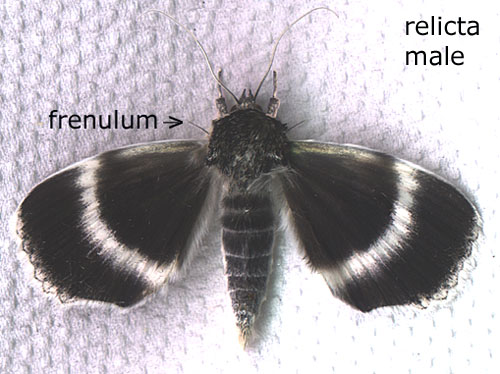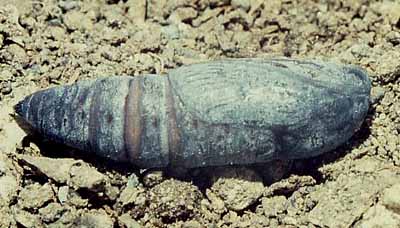

I've been able to capture moths at mercury vapour lights and
recognize females using two methods:
1) examination of abdomen--females tend to have a shorter "turkey baster"
shape while males have abdomens which taper consistently and
gradually.
2) examination of frenulum--males have a single stiff spine at the
top of the hindwing very close to the juncture with the thorax; females
have multiple, softer spines which project at an angle closer to the wing.
When I capture a moth whose abdomen seems to indicate it is a female, I
examine the frenulum for confirmation.
I hold the moth at the base of the forewings between the thumb and index finger
of one hand and gently use the other forefinger or thumb
to put some (considerable) separation between the hindwing and the forewing.
I'm getting better with experience and can usually spot the male "spine" in bright
light when my initial diagnosis has been wrong. A hat-, partner- or
mouth-held
flashlight will probably be necesssary in the field.
The spine in
each case tended to be dark and projected at an initial angle of
about 60 degrees from the edge of the wing, curving downward slightly.
In the case of females, the frenula were
lighter in colour, smaller in size (length and girth), multiple and projected almost parallel
to the wing edge.
Confirmed females were placed in inflated brown paper grocery bags and have
thus far deposited eggs on the flat sides and bottom of the grocery
bag, in folds of a wrinkled/crinkled brown paper sandwich bag added to
the "housing unit" and even on
a crinkled napkin moistened with a sugar/fruit mix and placed on the
bottom of the grocery bag.
It may be necessary to put moths in sleeves over
appropriate hosts to get maximum egg deposition.
It is difficult to get high quality photographs of eggs which
are extremely small, much smaller than typical
Saturnidae and Sphingidae eggs. Relicta
a very dark grey brown while those of concumbens have a rosy
hue. The Kirby Wolfe images below are the best I have seen and reveal
some of the intricacy of these
finely sculpted orbs.
Catocala concumbens courtesy of Kirby Wolfe
Catocala relicta
courtesy of Kirby Wolfe.
Hopefully I will have larvae in the spring. Those eggs in the
microcentrifuge tubes (just to further conserve moisture) will be
taken out of cold storage when poplar foliage becomes available,
poured out of the tubes into a
litre (approx. quart) sized clear plastic storage tub, lid on tight
and no air holes, kept at room temperature and watched carefully for
newly emerged larvae.
Those eggs stored outdoors will receive similar treatment when poplar
leaves have opened.
Foliage will only be offered once eggs have hatched. Some larvae will
be reared
indoors on cut food in airtight containers and other larvae will be
reared outdoors in sleeves.
It is my hope to get scans of the larvae in each of the instars.
It is my understanding that usually the pupae
are covered with a powdery bloom, and they emerge in two to three
weeks.
Catocala aholibah pupa courtesy of Jeremy B.Tatum and Dr. John
Snyder.
"Catocala ilia are placed in a paper bag for 2 -3 nights with no food. Adults are removed to outdoor screened cages in the morning and sprayed heavily with
water three times and then placed back in the bags at dusk. On the 4th night I introduce my bait mixture on a container lid at the bottom of an inflated grocery
bag.
"I take two pieces of burr oak bark and wire it onto both sides of the bag and the females will dump just about all their eggs the 4th night."
I separated the forewings of a
few "euthanized" males from their bodies and examined the frenula.



Return to Main Catocala Index
Ian Miller writes, "My catocala egg obtaining technique is a matter of conditioning females prior to their peak egg deposition. I have been
working with several females of various species including relicta which are by far the easiest Catocala to obtain eggs from. At maturity, the larvae wil be moved to pupation
buckets or tubs.
